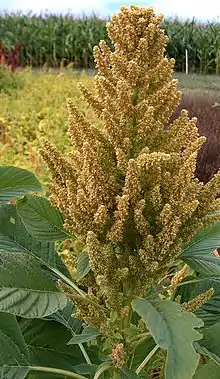| Amaranthus hybridus | |
|---|---|
 | |
| Scientific classification | |
| Kingdom: | Plantae |
| Clade: | Tracheophytes |
| Clade: | Angiosperms |
| Clade: | Eudicots |
| Order: | Caryophyllales |
| Family: | Amaranthaceae |
| Genus: | Amaranthus |
| Species: | A. hybridus |
| Binomial name | |
| Amaranthus hybridus | |
| Synonyms[1] | |
|
List
| |
Amaranthus hybridus, commonly called green amaranth,[2] slim amaranth,[3] smooth amaranth, smooth pigweed, or red amaranth, is a species of annual flowering plant. It is a weedy species found now over much of North America and introduced into Europe and Eurasia.
Description

Amaranthus hybridus grows from a short taproot and can be up to 2.5 m in height. It is a glabrous or glabrescent plant.
Distribution
Amaranthus hybridus was originally a pioneer plant in eastern North America. It has been reported to have been found in every state except Wyoming, Utah, and Alaska. It is also found in many provinces of Canada, and in parts of Mexico, the West Indies, Central America, and South America. It has been naturalized in many places of warmer climate. It grows in many different places, including disturbed habitats.
Taxonomy
It is extremely variable, and many other Amaranthus species are believed to be natural hybridizations or derive from A. hybridus.
As a weed
Although easily controlled and not particularly competitive, it is recognized as a harmful weed of North American crops.
Uses
The seeds and cooked leaves are edible.[4]
The plant was used for food and medicine by several Native American groups and in traditional African medicine. It is among the species consumed as Quelite quintonilli in Mexican food markets. It has weak antimicrobial activity, but contains promising anti-cancer phytochemicals.[5]
References
- ↑ "The Plant List".
- ↑ BSBI List 2007 (xls). Botanical Society of Britain and Ireland. Archived from the original (xls) on 2015-06-26. Retrieved 2014-10-17.
- ↑ USDA, NRCS (n.d.). "Amaranthus hybridus". The PLANTS Database (plants.usda.gov). Greensboro, North Carolina: National Plant Data Team. Retrieved 7 January 2016.
- ↑ Elias, Thomas S.; Dykeman, Peter A. (2009) [1982]. Edible Wild Plants: A North American Field Guide to Over 200 Natural Foods. New York: Sterling. p. 72. ISBN 978-1-4027-6715-9. OCLC 244766414.
- ↑ Romero-Benavides, Juan Carlos; Guaraca-Pino, Evelyn; Duarte-Casar, Rodrigo; Rojas-Le-Fort, Marlene; Bailon-Moscoso, Natalia (December 2023). "Chenopodium quinoa Willd. and Amaranthus hybridus L.: Ancestral Andean Food Security and Modern Anticancer and Antimicrobial Activity". Pharmaceuticals. 16 (12): 1728. doi:10.3390/ph16121728. ISSN 1424-8247. PMC 10747716. PMID 38139854.
External links
